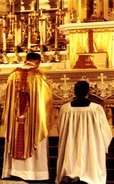Taken from NLM
The Italian journal, 30Giorni (30Days) has a piece up, Liturgia e poveri, tesori della Chiesa, which is an interview with Archbishop Malcolm Ranjith, the Secretary of the Congregation for Divine Worship.
[Extract]
One of your interviews [alla Croix del 26 giugno], entitled The Liturgical Reform of Vatican II has never been repudiated (decollata?) and has made a good deal of noise. Can you explain better your judgments about the liturgical reform that occurred after the Second Vatican Council?
RANJITH: These words are beyond dispute. It's not that everything that occurred after the Council has negative value. I said instead that the awaited result of the liturgical reform has not yet appeared. We can ask ourselves whether liturgical life, the participation of the faithful at sacred functions, is higher and better today compared to that which was present during the 1950s. It is alleged as a critical fact that before the Council the faithful did not truly participate at Mass, but assisted passively or made their private devotions. But today, is it really true that the faithful participate in a more elevated and personal spiritual manner? Has it really happened that the many who had been outside the Church, with the new liturgies, are now standing in line to enter the new churches? Has it not been the case instead that many went away and that the churches emptied? Of what reform can we then speak?
Subscribe to:
Post Comments (Atom)



No comments:
Post a Comment